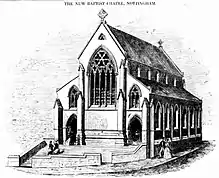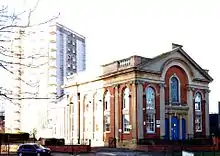William Booker (architect)
William Booker (2 November 1800 – 20 December 1861) was an English architect based in Nottingham.


Career
He was born on 2 November 1800 in Nottingham, the son of Richard Booker (1761–1833) and Hannah Davis (d. 1830) and baptised in St Mary's Church, Nottingham on 9 November 1800.
He married Eliza Foster (d. 1884), daughter of John Foster and Elizabeth of Nottingham. They had the following three children who entered into an architectural partnership in Nottingham.
- William Henry Booker (1826–1896)
- Frederick Richard Booker (1827–1882)
- Robert Booker
He learned his trade in the offices of Henry Moses Wood.
He was admitted to the freedom of the Borough of Nottingham in 1831. He was surveyor to the Freemen’s Rights’ Committee as the referee under the Nottingham Enclosure Act.
He died on 20 December 1861[1] at Cromwell Terrace, Nottingham and was buried in the Nottingham General Cemetery.
Notable works
- General Baptist Chapel, Milton Street, Nottingham 1849–50[2] (now demolished)
- Derby Road Baptist Church, Nottingham 1850–51[3] (with John Thomas Emmett - now demolished)
- Albion Congregational Church, Sneinton Road, Nottingham 1855–56 (with Thomas Oliver).[4]
- Scotch Baptist Chapel, East Circus Street, Nottingham 1858–59[5] (now demolished)
References
- "Death of Mr William Booker". Nottinghamshire Guardian. England. 24 December 1861. Retrieved 3 February 2019 – via British Newspaper Archive.
- "The New General Baptist Chapel". Nottingham Review and General Advertiser for the Midland Counties. England. 25 October 1850. Retrieved 3 February 2019 – via British Newspaper Archive.
- "New Baptist Meeting". Nottingham Journal. England. 5 April 1850. Retrieved 3 February 2019 – via British Newspaper Archive.
- Harwood, Elain (2008). Pevsner Architectural Guides. Nottingham. Yale University Press. p. 150-51. ISBN 9780300126662.
- Pevsner, Nikolaus; Williamson, Elizabeth (1979). The Buildings of England. Nottinghamshire. Penguin Books. p. 242. ISBN 0140710027.